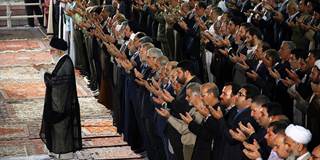The Islamic Republic of Iran is both a historical relic and a contemporary dynamo. Despite having lost legitimacy in the eyes of most Iranians, the regime has managed to expand its influence beyond its borders – and is close to achieving its goal of regional hegemony.
WASHINGTON, DC – Of the states that emerged from the twentieth century’s three great revolutions – in Russia in 1917, China in 1949, and Iran in 1979 – the Islamic Republic of Iran alone endures in something close to its original form. Modern-day Iran is thus a historical relic; but it is also a contemporary dynamo. Its revolutionary regime is increasingly sclerotic and beleaguered. And yet, in recent years, it has managed to exert ever-more power and influence beyond its borders.
Two recent books help to explain how this paradox came about. Democracy in Iran, by Dartmouth College sociologist Misagh Parsa, examines Iran’s domestic political evolution since the revolution. And The Iran Wars, by Jay Solomon, a former foreign affairs correspondent for the Wall Street Journal, assesses Iran’s foreign policy in the twenty-first century, with an emphasis on its relations with the United States.
The Last Revolution
Like the revolutions in Russia and China, the Iranian Revolution brought to power an entirely new elite that reshaped the country’s political and economic order on the basis of a radical ideology. Like them, it was led by a shrewd, charismatic, tactically flexible, and supremely ruthless leader, with the Shia Muslim cleric Grand Ayatollah Ruhollah Khomeini playing the same role that Vladimir Lenin and Mao Zedong did in Russia and China. And all three revolutions made extensive use of violence. Like the Bolsheviks and the Chinese Communist Party, the Islamic Republic conducted a campaign of terror against its opponents – real and imagined – and consolidated its power through severe repression.

WASHINGTON, DC – Of the states that emerged from the twentieth century’s three great revolutions – in Russia in 1917, China in 1949, and Iran in 1979 – the Islamic Republic of Iran alone endures in something close to its original form. Modern-day Iran is thus a historical relic; but it is also a contemporary dynamo. Its revolutionary regime is increasingly sclerotic and beleaguered. And yet, in recent years, it has managed to exert ever-more power and influence beyond its borders.
Two recent books help to explain how this paradox came about. Democracy in Iran, by Dartmouth College sociologist Misagh Parsa, examines Iran’s domestic political evolution since the revolution. And The Iran Wars, by Jay Solomon, a former foreign affairs correspondent for the Wall Street Journal, assesses Iran’s foreign policy in the twenty-first century, with an emphasis on its relations with the United States.
The Last Revolution
Like the revolutions in Russia and China, the Iranian Revolution brought to power an entirely new elite that reshaped the country’s political and economic order on the basis of a radical ideology. Like them, it was led by a shrewd, charismatic, tactically flexible, and supremely ruthless leader, with the Shia Muslim cleric Grand Ayatollah Ruhollah Khomeini playing the same role that Vladimir Lenin and Mao Zedong did in Russia and China. And all three revolutions made extensive use of violence. Like the Bolsheviks and the Chinese Communist Party, the Islamic Republic conducted a campaign of terror against its opponents – real and imagined – and consolidated its power through severe repression.